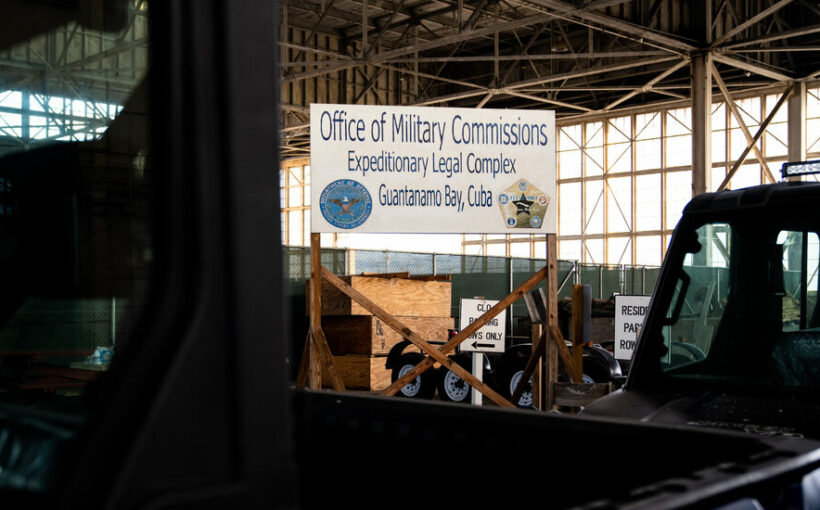GUANTÁNAMO BAY, Cuba — In court this week, a psychologist who waterboarded prisoners for the Central Intelligence Agency rolled up a towel, wrapped it around the neck of a criminal defense lawyer, and slowly pulled the lawyer toward him and up on her toes — a dramatic re-enactment of practices used on a Saudi detainee in the war on terrorism.
There was no waterboarding or commanding the defense lawyer to crawl into a cramped confinement box. But the demonstration on Wednesday by the psychologist, John Bruce Jessen, was meant to replicate some of the approved “enhanced interrogation techniques” that C.I.A. agents used on the Saudi prisoner, Abd al-Rahim al-Nashiri, at a secret interrogation site in Thailand in late 2002.
Defense lawyers used the demonstration in an effort to persuade a military judge to exclude certain evidence from Mr. Nashiri’s trial as the fruit of torture. The judge, Col. Lanny J. Acosta Jr., allowed the presentation to show practices that C.I.A. officials had destroyed video evidence of two decades ago.
Mr. Nashiri is accused of plotting Al Qaeda’s suicide bombing of the U.S. Navy destroyer Cole off the coast of Yemen on Oct. 12, 2000. Seventeen American sailors died.
In years of pretrial hearings, mostly over the lawfulness of evidence for Mr. Nashiri’s eventual death-penalty trial, his lawyers have portrayed him as deeply damaged by physical, psychological and sexual abuse in his nearly four years of C.I.A. detention.
More on U.S. Armed Forces
His lawyers argue that by the time federal agents questioned Mr. Nashiri at Guantánamo in 2007, he was so thoroughly conditioned that he told his interrogators what they wanted to hear. It was four years into his captivity; he had never been allowed to consult a lawyer. The judge is deciding whether those 2007 interrogations are admissible at trial, as the war court wrestles with the legacy of torture after the Sept. 11, 2001, attacks.
Dr. Jessen testified that the practices — including waterboarding, nudity and isolation — were not meant to rob a prisoner of his will but to gain his cooperation and disclose Al Qaeda’s secrets to the C.I.A.
“It’s all about establishing rapport and finding that path ahead,” he said.
Dr. Jessen, who spent 20 years in the U.S. Air Force and specialized in survival training, called the interrogations “well monitored” but “very intense.” C.I.A. headquarters would relay to him messages such as: “Get a spine. Tell us when the next attacks would be.”
Prosecutors have already agreed that nothing Mr. Nashiri said at the so-called black sites can be used at trial because evidence derived from torture and cruel, inhuman or degrading treatment is unlawful. But they defend as untainted his 2007 law enforcement interviews, which took place at Guantánamo at a former C.I.A. prison where Mr. Nashiri was held by the agency in 2003 and 2004.
To bolster that claim, prosecutors plan to call a forensic psychiatrist, Dr. Michael Welner, to testify next week that an examination of Guantánamo records and court observations indicates that the detainee has no signs of post-traumatic stress disorder.
Dr. Jessen said he imposed safeguards on the techniques he and his waterboarding partner, James E. Mitchell, employed, including having other psychologists monitor the interrogations to essentially make sure they were doing no harm.
Mr. Nashiri was waterboarded multiple times before interrogators abandoned the technique on him. The detainee, who is 5-foot-5, kept slipping from his straps — the “safety equipment” on the board that was built for the first person the interrogators had waterboarded, Abu Zubaydah, who was 5-foot-10.
But Dr. Jessen also acknowledged that “unfortunate things” happened to the prisoner when he was not observing the interrogations. Dr. Jessen later learned, he said, that Mr. Nashiri was held with arms strung up over his head, chained to a wall and sodomized.
An internal investigation also showed that a C.I.A. interrogator simulated Russian roulette. A drill was revved next to Mr. Nashiri’s hooded head. Dr. Mitchell has testified that guards bent him over backward, a broomstick behind his knees, leaving Mr. Nashiri howling in pain.
Dr. Jessen also testified that the C.I.A. ran a rival black site program that he learned about later.
Dr. Jessen was testifying to the court in Guantánamo on a video link from a secret courtroom annex in Virginia, near the Pentagon. The cinematography was sharp, and the audio picked up his surprise and reluctance at illustrating certain interrogation techniques when a defense lawyer, Annie Morgan, asked him to stage the demonstration on her.
“I’ll wreck your suit,” Dr. Jessen protested, while Colonel Acosta appeared startled. “You want him to slap you?” he said.
“Don’t worry, judge, I’m not going to have him waterboard me,” said Ms. Morgan, a former Air Force lawyer.
Dr. Jessen protested that he had no towel. If a prisoner was only in a diaper or nude, he explained, interrogators used a towel. One was produced. Ms. Morgan stood at attention and then the psychologist illustrated a towel-assisted “attention grasp.” He explained that the purpose was “to dislocate your expectation” — to condition a prisoner to understand that “this is real, this person wants me to pay attention.”
“I feel like I’m beating up my daughter,” Dr. Jessen remarked as the demonstration proceeded.
Source: Read Full Article
